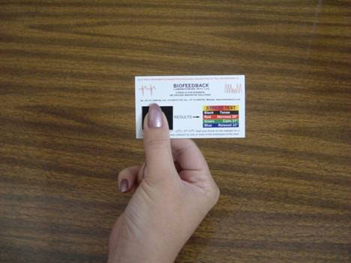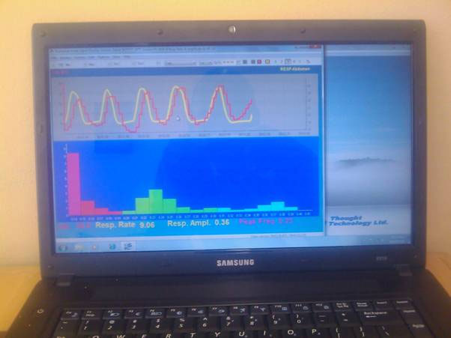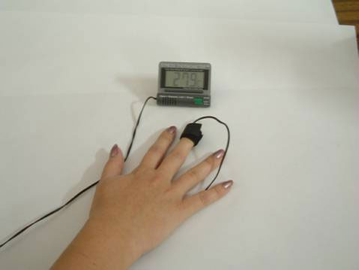Extended Overview of Biofeedback
• What is Biofeedback?
• Why Biofeedback?
• Which Biological Processes Does Biofeedback Monitor?
• Sample Biofeedback Devices.
• What Happens During Biofeedback Treatment?
• Who Can Offer Biofeedback Treatment Services?
• Conditions Treated By Biofeedback.
• Evidence Based Practice in Biofeedback and Neurofeedback.
What is Biofeedback?
Biofeedback is a form of behavioural treatment which makes use of electronic and other mechanical devices to monitor and display an individual’s biological processes too subtle for normal awareness, such the dilation and contraction of peripheral blood vessels. The individual then uses the feedback provided by the displays to learn how to control the biological responses. We refer to this as physiological self-regulation.
Why Biofeedback?
There are at least three reasons why there is great benefit to using biofeedback.
• To learn to control physiological processes associated with ill health. Examples include: Learning to dilate peripheral blood vessels (as medications do) in order to reduce blood pressure; learning muscle relaxation to deal with pain symptoms such as headache and neck pain; achieving relaxed brain states for the treatment of anxiety and depression.
• Biofeedback is a non-invasive treatment, in the sense that you can achieve some of your biological treatment goals without medication or surgery. Persons on treatment using biofeedback however, should never stop or reduce medications without the approval and supervision of their regular medical practitioner.
• Self-improvement: To improve concentration, memory, and creativity.
• Peak performance in sport and other areas of life.
Which Biological Processes does Biofeedback Monitor?
Most of our actions, feelings, and thoughts are controlled by processes that are too subtle or microscopic for us to be aware of them. We normally consider these processes to be autonomic, involuntary, or subconscious. Here are some examples.
Heart beat We normally feel we have no control over what our heart does. For example, when we are afraid or stressed for any reason, it beats faster. The electrical activities of our hearts normally proceed without our awareness or control.
Blood Volume
Our blood vessels dilate and constrict in response to changes in the environment such as heat or physical exertion. The same dilation and constriction of blood vessels also takes in response to emotional states like fear, anger, and excitement. Biofeedback devices can detect in real-time blood volume changes.
Temperature
This is related to blood volume just described above. Blood is warm. Fear or panic for example, reduces blood volume in the vessels of the skin. Reduced blood = reduced peripheral body heat.. Thermometers specially designed for biofeedback can monitor the subtle temperature changes.
Muscle Activity
Voluntary muscle activity, such as lifting a ball, is not normally a direct target for biofeedback. However, muscle action such as the tensing of our face and jaw muscles when angry or trembling in fear, occur involuntarily. These are the result of sympathetic nervous system activation of involuntary smooth muscles. Even in the performance of voluntary actions, such as lifting a weight, we are not normally aware of, or consciously in control of, the electrical activity at the microscopic level in the muscle, the single motor neuron.
Sweating
When we are in an intense emotional state, we do not decide to sweat. It just happens. This type of sweating is not the same as sweating during physical exertion, which takes place in order to cool the muscles and the body. “Breaking out in a cold sweat” like this is amenable to assessment and modification by the use of biofeedback devices.
Breathing Emotional states and behavioural disorders like anxiety and depression are associated with several features of abnormal breathing: Breath-holding, breathing too fast, or a greater tendency to thoracic (chest) breathing, instead of relaxed slow abdominal breathing. Breathing is one of the most accessible biological process for voluntary control using biofeedback.
Brain waves
All behaviour is the result of electrical activity in the brain. When we sleep or relax, we produce slow brain waves. On the other hand, when we focus attention or consciously try to solve problems, we produce fast brain waves. We are normally not aware of or able to control these biological processes. The form of biofeedback called neurofeedback (EEG Biofeedback) utilizes EEG devices to monitor and train brainwaves.
Sample Biofeedback Devices

Stress Card
One of our associates checking out her stress levels on our stress card. The stress card is a special type of thermometer for finger temperature. As finger temperature increases with increased blood flow, the coloured square under the thumb changes from black through red, to green, and blue.
Omnibus Biofeedback Devices
Omnibus biofeedback devices take multiple simultaneous physiological measurements, typically temperature, respiration, skin conductance, blood volume, muscle tension, heart rate, brain waves, and muscle tension.
Screen image of a psychophysiological evaluation. The patient was undergoing Heart Rate Variability (HRV) training (Synchronizing heart rate with breathing rate, to reduce blood pressure).
Equipment and Software: Procomp Infiniti: Thought Technology Ltd


Stress Thermometer
The stress thermometer, like the stress card monitors finger temperature changes associated with tension or stress. This thermometer monitors temperature changes to a tenth of a degree.
What Happens During Biofeedback Treatment?
A person presenting for biofeedback will undergo a process that is typical of any clinical evaluation and treatment. This include,
• First Session: Clinical interview to identify presenting symptoms (if any), purpose of consultation, and psychological tests if necessary.
• Biofeedback Assessment Session: The therapist uses biofeedback devices to establish baselines of one or more of the physiological processes of interest such as EEG, EMG, temperature, breathing, sweating, and any other. Data is analysed for patterns of physiological reactivity, before setting up a treatment plan.
• Follow-up Sessions: These are Treatment/ Training sessions: Broadly speaking, these are behaviour therapy treatment procedures and they take place as follows: The patient or client is hooked up to a device that monitors a physiological process of interest and he or she watches the live results on the computer screen. Through processes of operant conditioning, the patient or client is assisted by the therapist to learn how to control the rate, size, or direction of physiological change. By watching their own body functions displayed on the screen, and learning to use different techniques, the patient or client eventually gains mastery over the physiological process.
